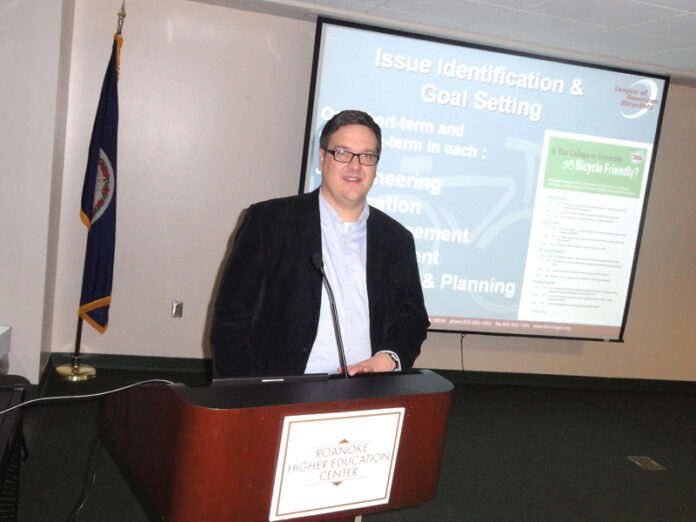
by Gene Marrano
Already designated as a bronze level bicycle-friendly community by the DC-based League of American Bicyclists, Roanoke City would like to go for the gold – and bring the entire valley along with it. That will take regional cooperation from local governments and VDOT, not to mention funding. The Roanoke Bike Summit brought together stakeholders and those with an interest in promoting cycling as a transportation alternative earlier this week, for two days at the Higher Education Center downtown.
The League of American Cyclists conducted the summit, which featured sections on Bicycle Friendly Universities, Businesses and Communities. Co-sponsored by the Roanoke Valley Alleghany Regional Commission, the commission’s Ride Solutions arm and the New River Valley Planning Commission, it was billed as being of interest to those concerned with environmental sustainability, air quality, transportation alternatives, fitness and quality of life.
At the Bicycle Friendly University session, Bill Nesper from the League of American Bicyclists said making a campus more bicycle friendly not only works on large, sprawling campuses like Virginia Tech, but also on more urban ones like Roanoke College and Hollins University. In addition, some colleges now offer for-credit courses on bicycling issues as part of recreation, engineering and health education curriculums, according to Nesper.
Dozens of schools across the country encourage students, faculty and staff members to bike to work, by offering safe bike paths or clearly marked roads, bike racks and repair centers – even cash incentives in some cases. There’s an education factor as well and a responsibility issue: “we want to make sure bicyclists on campus are doing the right thing,” said Nesper.
Stanford University in California is the only campus to have been designated as a platinum-level bicycle friendly university by the League to date. George Mason in Northern Virginia has received the bronze designation. “We don’t have a lot of small liberal arts colleges [and] we want more community colleges to apply,” Nesper noted. Connectivity to safe bike lanes on roads leading into the campus is an issue – if it’s too dangerous to ride from home, even if the campus itself is a safe environment, many will just continue to take their cars.
There are currently around 180 communities designated as bicycle-friendly in the U.S., including Roanoke. The community program is less than a decade old. Nesper said the League of American Cyclists (LAB) was willing to “assess Roanoke’s bicycle assets,” and pointed to a number of federal, state and private funding streams that could help fund programs to make a region more bike friendly. (see bikeleague.org for more information)
Nesper hailed Roanoke’s Sharebike program, where people can rent bicycles for little or no charge, as a “really good example,” of such an effort. As for bicycle friendly businesses, items such as secure on-site bike parking, shower facilities, having a bike club and incentives for commuting on two wheels are part of the mix.
Bicycle friendly communities require some heavy lifting: a comprehensive, connected and well-maintained biking trail network, bike parking, safety education courses and local ordinances that treat bicyclists equitably with motorists.
Shane Sawyer, a planner with the Roanoke Valley Alleghany Regional Commission and a biking advocate himself – he pedals to work downtown – said the purpose of the Roanoke Bike Summit was to share information. Roanoke City has just resubmitted an application to LAB, hoping to seek a designation higher than bronze, according to Sawyer. Three local businesses have also submitted applications seeking the bicycle friendly status. Tax incentives are available to help reimburse people who bike to work.
“The activities [that qualify for bike-friendly status] are broad and diverse,” said Sawyer, who is also involved with the “Bridge the Gap” campaign. That public effort aims to raise the seven million dollars or more still needed to fill in the last four miles on the Roanoke River Greenway from Salem to Roanoke City, which will complete an 18-mile section of greenway. “It is a major alternative transportation corridor,” said Sawyer, who expects demand for adjoining bike-friendly roads and connecting greenways to grow at that point.
“We hope to put Roanoke on the map as a bicycle-friendly region,” said Sawyer. He added that while there has been plenty of progress in the area towards making the valley more bike friendly, there is more to be done.
Cooperation among all the stakeholders is a major component in becoming truly bicycle friendly. “There is a lot of cooperation going on amongst the local governments and the various agencies,” said Sawyer, who is also an LAB-certified bicycle education instructor. Getting more bike lanes striped or carved out along roadsides will require some heavy lifting however: “VDOT has to be a partner in providing accommodations.”


